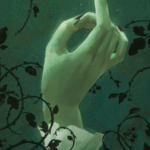10 Literary Translators on the Art of Translation
"Like the ghostwriter, the translator must slip on a second skin."
This year, for the first time, the National Book Foundation awarded a National Book Award for Translated Literature. As was no doubt their intention, the prominence of the award served not only as a way to celebrate great translated literature (and translators) but also as a little push to the book lovers of America to keep reading it and thinking about it—and for some, to stop and reflect on translation as a literary form. After all, there are few literary feats more magical—and more mysterious to those of us unfamiliar with the language of the source text. (In college, I met someone who told me that I would learn Russian easily and in a matter of months if I just sat down and worked my way through The Master and Margarita in the original, with a dictionary. Reader, it did not work.) Just because I’m interested, and so maybe you are too, and knowing that I can only scrape the surface of the alluring world of translation, I dug into what a few of its practitioners had to say about the craft. Add onto this list at will below.
Lara Vergnaud, English translator of Mohand Fellag, Joy Sorman, Marie-Monique Robin, Ahmed Bouanani, and Scholastique Mukasonga, among others:
Translation is a curious craft. You must capture the voice of an author writing in one language and bear it into another, yet leave faint trace that the transfer ever took place. (The translator extraordinaire Charlotte Mandell calls this transformation “Something Else but Still the Same.”) Though spared the anguish of writer’s block, the translator nonetheless has to confront the white page and fill it. The fear: being so immersed in the source text, adhering so closely to the source language, that the resulting prose is affected and awkward—or worse, unreadable. Yet immersion is inevitable. In fact, it’s required.
Like the ghostwriter, the translator must slip on a second skin. Sometimes this transition is gentle, unobtrusive, without violence. But sometimes the settling in is abrupt, loud, and even disagreeable. For me, “plunge deep” tactics that go beyond the mechanics of translation help: coaxing out references to reconstruct the author’s cultural touchstones (books, film, music); reading passages aloud, first in the original and then in translation, until hoarseness sets in; animating the author’s story through my senses, using my nose, my ears, my eyes, and my fingers; devouring every clue to imprint the range of the author’s voice (humor, anger, grief, detachment) on my translation.
–from Vergnaud’s 2018 essay “Translation, in Sickness and in Health“
Jhumpa Lahiri, English translator of Domenico Starnone’s novels:
Needless to say, translating Starnone enriches my Italian vocabulary and deepens my understanding of the syntax. It reveals new cadences. But, beyond that, I have the great privilege of scrutinizing the very mechanism of his novels, of probing the structure and supporting tissue. There is no better lesson for a writer. Translation goes beyond reading; the act is visceral as opposed to merely intimate, and it impacts you, it teaches you in a different way. . . . Translation is more pleasurable to me than writing fiction, given that I am in an intense relationship with a text I profoundly admire, greedy to absorb all that it has to offer. I question what I am producing, but that dialogue with the original text stimulates me, keeps me company, keeps me afloat. Writing is a sustained monologue, a profoundly solitary act. A place where there is no escape from myself and, paradoxically, a place of total freedom.
–in a 2018 interview with Cressida Leyshon
Vladimir Nabokov, English translator of Pushkin, among others:
Three grades of evil can be discerned in the queer world of verbal transmigration. The first, and lesser one, comprises obvious errors due to ignorance or misguided knowledge. This is mere human frailty and thus excusable. The next step to Hell is taken by the translator who intentionally skips words or passages that he does not bother to understand or that might seem obscure or obscene to vaguely imagined readers; he accepts the blank look that his dictionary gives him without any qualms; or subjects scholarship to primness: he is as ready to know less than the author as he is to think he knows better. The third, and worst, degree of turpitude is reached when a masterpiece is planished and patted into such a shape, vilely beautified in such a fashion as to conform to the notions and prejudices of a given public. This is a crime, to be punished by the stocks as plagiarists were in the shoebuckle days.
. . .
We can deduce now the requirements that a translator must possess in order to be able to give an ideal version of a foreign masterpiece. First of all he must have as much talent, or at least the same kind of talent, as the author he chooses. In this, though only in this, respect Baudelaire and Poe or Joukovsky and Schiller made ideal playmates. Second, he must know thoroughly the two nations and the two languages involved and be perfectly acquainted with all details relating to his author’s manner and methods; also, with the social background of words, their fashions, history and period associations. This leads to the third point: while having genius and knowledge he must possess the gift of mimicry and be able to act, as it were, the real author’s part by impersonating his tricks of demeanor and speech, his ways and his mind, with the utmost degree of verisimilitude.
–from Nabokov’s 1941 essay “The Art of Translation“
Ann Goldstein, English translator of Elena Ferrante’s Neopolitan Novels:
I have to do the first draft quickly. But I think Lydia Davis says she doesn’t even read the book first. I feel that you have to know what’s at the end in order to get the right tone in the beginning. It’s not a question of individual words. You’re not going to translate the same words the same way all the time. Although I did once hear a translator—perhaps it was Linda Coverdale—say that she was very careful to do that. Actually, apparently there are now programs that you can use that will tell you how you translated a word previously. I can’t imagine! Maybe it would be useful… But, anyway, I feel that you have to know what happens at the end to be true to the beginning in terms of the language. I’m sure that if I read all the Neapolitan novels again there would be things I would probably do differently. Even the structure of the sentences I would like to do differently. . . . I’m not saying that I would take away the run-on sentences, because I do think they serve a purpose and they’re certainly there in the Italian. They are somewhat modified in the English—it’s just too hard in English. I don’t know, it’s hard to say what I might have done differently. I might have done fewer or more, I might have changed the pace. It’s always a hazard of translation—you’re constantly second-guessing yourself and at a certain point it loses its usefulness.
–in a 2016 interview with Melinda Harvey
Idra Novey, English translator of Clarice Lispector’s The Passion According to G.H., among others:
I’ve found that translation begins with the prefix “trans” for a reason. Like transcendence and transformation, it requires an acceptance of progressing with uncertainty, which is essential for authors who want to write around and over what’s currently expected from a novel. The prefix “trans” comes from the Latin word for “across.” . . . In a translation, playing around with style is everything. The author provides the plot and characters. The opening and closing scenes already lie there, waiting. All the translator has to do is figure out what music, tone, and cadence will recreate what makes that author’s delivery of those scenes worth translating. MFA programs can teach many of these skills as well, but the renegade stylistic training inherent in the act of translation is free to anyone with a library card or access to the Internet.
–from Novey’s 2016 essay “Writing While Translating“
Lydia Davis, English translator of Gustave Flaubert’s Madame Bovary, among others:
So, here we have the first two pleasures of translating: (1) the pleasure of writing; and (2) the pleasure of solving a puzzle.
(1) In translating, you are forming phrases and sentences that please you at least to some extent and most of the time. You have the pleasure of working with sound, rhythm, image, rhetoric, the shape of a paragraph, tone, voice. And—an important difference—you have this writing pleasure within the island of the given text, within its distinct perimeter. You are not beset by that very uncomfortable anxiety, the anxiety of invention, the commitment to invent a piece of work yourself, one that may succeed but may also fail, and whose success or failure is unpredictable.
(2) In translating, then, you are at the same time always solving a problem. It is a word problem, an ingenious, complicated word problem that requires not only a good deal of craft but some art or artfulness in its solution. And yet the problem, however complicated, always retains some of the same appeal as those problems posed by much simpler or more intellectually limited word puzzles—a crossword, a Jumble, a code.
–from Davis’s 2016 essay “Eleven Pleasures of Translating“
Elena Marcu, Romanian translator of James Baldwin’s Giovanni’s Room:
With Baldwin, there are at least five ways to say what he wrote, and most of the times, none of them seemed quite right.
My room was never completely quiet. I read each translated sentence out loud to hear how it spoke. Was my voice in there? Change it! And repeat. Over and over and over. When the book speaks, I have to remain mute.
Eventually, I set a deadline to finish the translation. I don’t quite know if it’s finished and I probably never will. It’s strange to feel there’s so much need for change to get closer to the core. To keep that rawness and that sophistication of language, thought and emotion, to make alterations to keep the meaning intact, the tone intact in such a different language, to preserve Baldwin’s mind in all its intensity, to elude the mental patterns that make translators who they are. Translators need to be invisible. They need to leave no trace, I reminded myself. They need to quietly live inside every word they’ve typed but didn’t write. They need to project, to reflect, not to mimic. They need to become someone else. They owe it to themselves to try.
–from Marcu’s 2018 essay “The Joy and Terror of Translation James Baldwin’s Giovanni’s Room“
Mark Polizzotti, English translator of work by Gustave Flaubert, Marguerite Duras and André Breton:
If we consider the translator the “servant” of the source text, charged with forging as close an equivalent as possible, then any deviation from the original syntax or structure, whether born of egotism, incompetence or cultural prejudice, will indeed seem a betrayal. If instead we take translators as artists in their own right, in partnership with (rather than servitude to) their source authors; if we think of translation as a dynamic process, a privileged form of reading that can illuminate the original and transfer its energy into a new context, then the act of representing a literary work in another language and culture becomes something altogether more meaningful. It provides a new way of looking at a text, and through that text, a world. In the best of cases, it allows for the emergence of an entirely new literary work, at once dependent on and independent of the one that prompted it—a work that neither subserviently follows the original nor competes with it, but rather that adds something of worth and of its own to the sum total of global literatures. This does not mean taking undue liberties with the original; rather, it means honouring that original by marshalling all of one’s talent and all of one’s inventiveness to render it felicitously in another language.
To present a work as aptly as possible, to recreate it in all its beauty and ugliness, grandeur and pettiness, takes sensitivity, empathy, flexibility, knowledge, attention, caring and tact. And, perhaps most of all, it takes respect for one’s own work, the belief that one’s translation is worth judging on its own merits (or flaws), and that, if done well, it can stand shoulder to shoulder with the original that inspired it.
–from Polizzotti’s 2018 essay “L’art de la traduction“
George Szirtes, English translator of Imre Madách, Sándor Márai and László Krasznahorkai, among others:
My way with fiction generally is to read the first chapter or so then to get down to it. It is far from scholarly. A kinder way of putting it might be that it isn’t pedantic. I listen intently for the timbre of the voice and seek a comparable voice in English that might bring to English the experience a native reader might have in Hungarian. Narrative proceeds from there.
We tend to think of translation in terms of dictionaries but that’s just the beginning. Literary precision includes the idea of effect, pace, register, intensity and much else. There isn’t always an exact equivalent for a word or phrase: it’s the effect of it that matters. Effect is partly a subjective judgment but so is writing. Nothing in English will capture the tone of Budapest slang. The word “melancholy” does not carry the association of the Hungarian bús (pronounced booosh), that conjures a whole literary period, so some equivalent sensation has to be found.
Most of my translatees have been dead a long time. The dead don’t quarrel. The best of the living, such as László Krasznahorkai, “hear” the translation as well as the opinion of the editor and trust the translator, who by definition never can be perfect. He and I rarely speak while the translation is in process.
–as told to The Guardian in 2016
Saskia Vogel, English translator of Karolina Ramqvist, among others:
I don’t aim for forensic fidelity in translation. I translate so that the reader will, above all, feel the book. Focusing on feeling is how I compensate for what will inevitably be lost; perhaps such coping mechanisms are the locus of a translator’s style. But perhaps I have focused too much on the word loss. The word try is also key. Try assumes a gap—between imagination and language, writer and text, text and translator, text and reader.
In an essay called “It’s the Night,” Ramqvist described how she feels like her writing moves through her body and materializes with the reader, emerging inside them. It is in this subjective place that a book is fully realized. But unlike a translator, the reader is not obligated to relay what the book is saying to anyone else, and they only have to think about what the book is saying to them. As with a reader’s reading, a translation is channeled through the translator’s experience of the world and language. As The White City emerged inside me, it found its resonance. The hard surfaces of my own experience helped me address the gap between the Swedish novel and my English translation. They were tools. In this way, perhaps the space between the text and its translation is a tool, too. A space for loss, a space for trying. An elusiveness that shouldn’t be feared but embraced, and that in its most refined form might inspire desire, as luxury or cool can, because of the room it leaves for interpretation. Because it makes us want to crack the code.
–from Vogel’s 2017 essay “The Swedish Gangster’s Wife’s Bag“




















